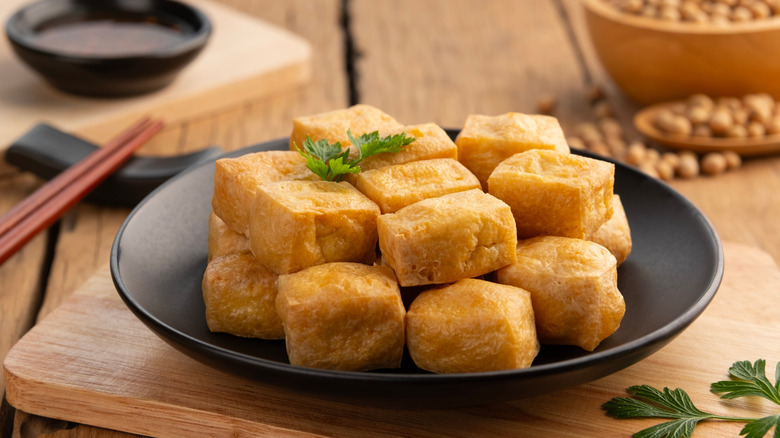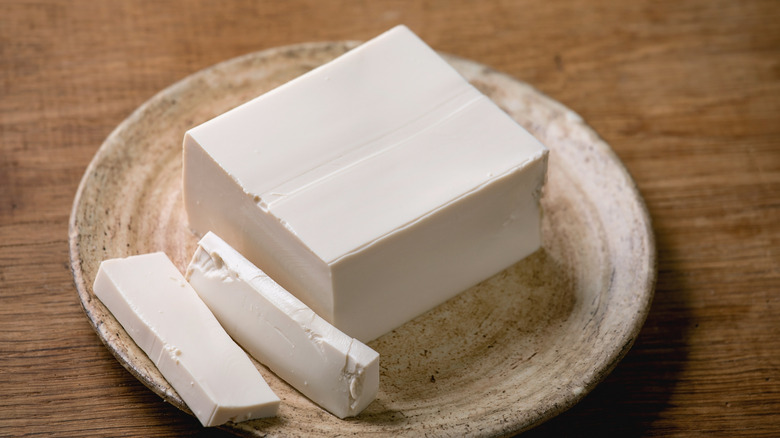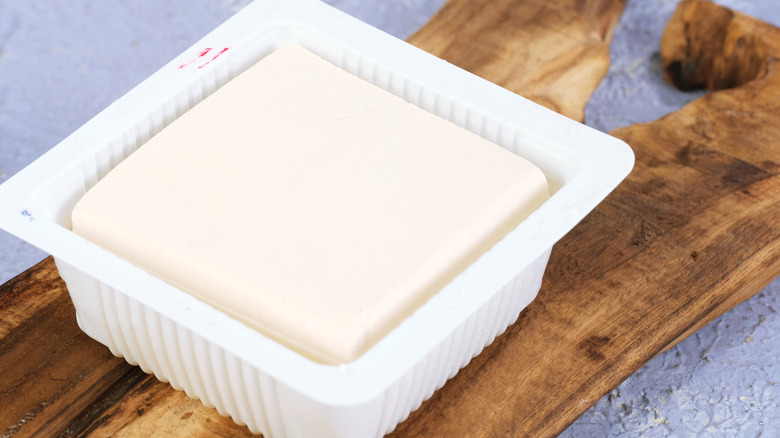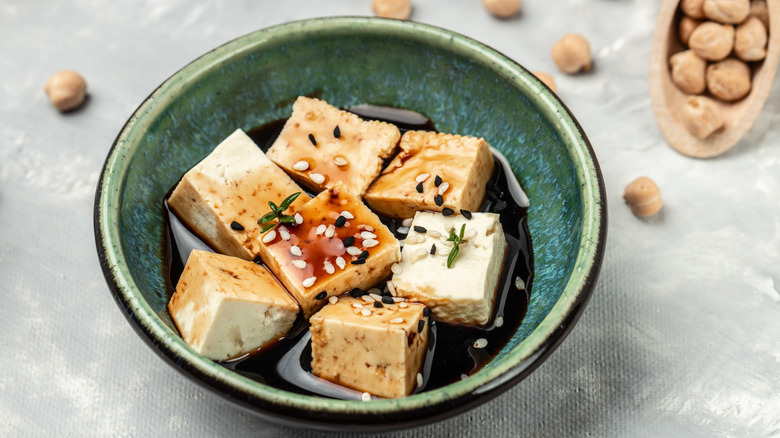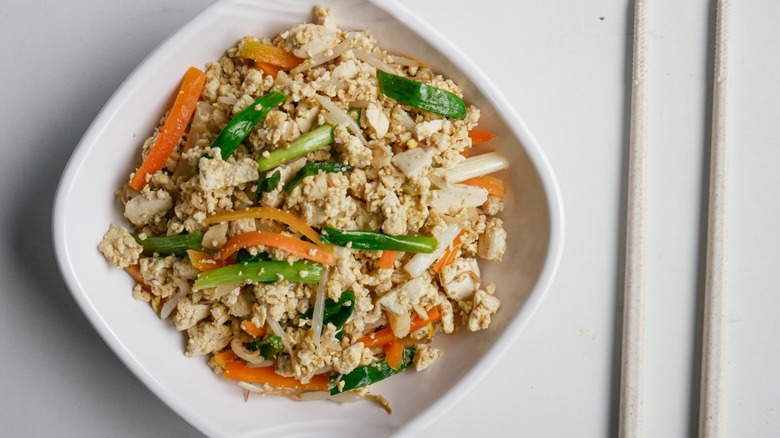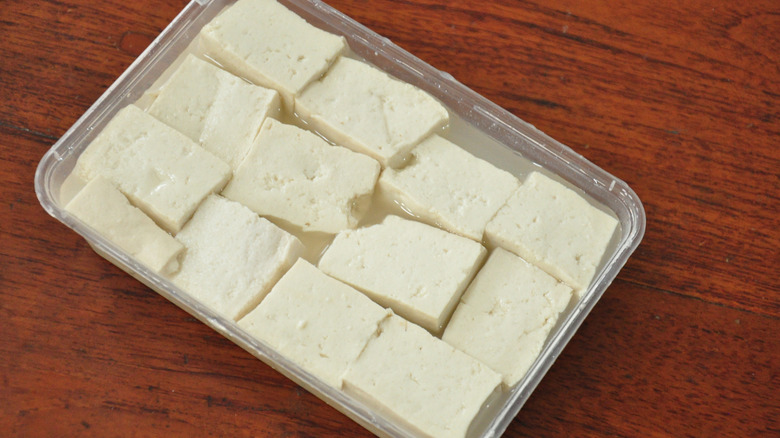12 Common Mistakes Everyone Makes When Cooking Tofu
We may receive a commission on purchases made from links.
If you've ever made a mistake cooking tofu, then you're certainly not alone. While nutritious, delicious, and budget-friendly, tofu is not a particularly intuitive ingredient. There's a lot to know about it, from the types of tofu that exist, to what it's made of, and how long tofu stays good after opening. When you lack knowledge, it's easier to err, especially if you're cooking with it for the first time.
In happier news, if you do know what you're doing, you'll find tofu to be one of the most versatile ingredients out there. You can easily incorporate it into protein bowl recipes for hasty weeknight dinners or use marinade to make a crispy, sticky baked sesame showstopper. It's even an amazing dessert addition, such as this two-ingredient vegan chocolate pudding.
In other words, if you're not already using tofu, then you're probably missing out. Chowhound recently had the opportunity to talk to several chefs about the main mistakes home cooks make when using tofu. From draining to cutting, marinades to temperatures, pan choice to storage, we got the goods on all things fermented soybean, so you never have to make a mistake again.
1. Choosing the wrong tofu for your recipe
Tofu is not dissimilar from cheese. Manufacturers make it by crushing soybeans and soaking them, then mashing them into a pulp, and separating the solids from the whey, just as cheesemakers do with milk. Different minerals and coagulants are added, then the curds are put into molds while additional whey drains off, causing the blocks to take on their characteristic shape. Different production methods lead to different tofu types: silken, soft, medium, firm, and extra firm.
A big mistake cooking tofu is to fail to account for the differences in properties between the five main types. "Different types of tofu have different textures, so they're not interchangeable," says Nisha Vora, New York Times bestselling author of "Big Vegan Flavor." "For instance, extra firm tofu and firm tofu have a lower water content, so they can stay intact when fried, stir-fried, or baked. In contrast, silken tofu is very soft, creamy, and delicate, and is difficult to fry unless you're an experienced tofu cook." If you substitute silken for firm in a stir fry, she says, you'll get nothing but a mushy mess.
Sean Demaine, private chef at La Belle, adds that tofu comes in other varieties as well, such as smoked, marinated, or otherwise flavored, "so it's important to pick one to suit the dish you are cooking." If you want to gain some caramelization, he says, you'll need to choose varieties that hold together for frying or grilling, such as firm and extra firm. On the other hand, soft and medium textures are great for tofu scrambles, while silken tofu is ideal for desserts and smoothies.
2. Draining tofu inadequately
One mistake cooking tofu is to drain it improperly. Tofu is preserved in water after fermentation, but that water needs to go before you cook with the curd, or else your recipe could be ruined. "Tofu is naturally water-heavy and packed in water, and water inhibits foods from crisping up when cooked and from absorbing maximum flavor," Nisha Vora says. "So if you want a crispy crust on your tofu or want it to soak up all the flavor in a marinade, draining tofu and removing some excess water is key."
Draining isn't a given, though. "It's best to follow the recipe's instructions," says Stephanie Kondrchek of Steph Sunshine. "In some types of recipes, the tofu's moisture is a necessary component of the finished dish, and in others, the excess moisture will evaporate during the cooking process."
If you are going to remove the water, it is important to drain the tofu thoroughly, lifting it from the water and drying it off, rather than just pouring off the liquid. If you find draining manually to be a pain, then there's a hack. Instead of draining and drying it by hand, you can submerge the tofu in boiling salted water for 10 minutes, Vora says. This hot water trick causes the tofu to contract — a byproduct of the proteins themselves growing taut — while the salt draws out the moisture. Once you pour the water back off, your tofu is naturally much less hydrated.
3. Failing to press firm and extra-firm tofu before cooking
Sometimes, draining isn't enough, but believing that draining and pressing are the same thing is a common mistake when cooking tofu. Because the firm and extra-firm tofu varieties are porous, they hold more moisture than their softer brethren. It's not enough to drain them, because they retain moisture on the inside even if they appear dry without, with the same downsides as improper draining. "Tofu's like a sponge," explains Dennis Littley of Ask Chef Dennis. "It can't absorb flavors if it's already full of water. Draining it gets rid of the excess moisture, so your marinades actually stick."
Plus, cautions Allie Peterson, founder of Naturallie Plant-Based, if your tofu is wet on the inside, "you may be unable to obtain a crispy exterior even with proper cooking methods." Having been christened the Tofu Queen by her followers, she takes the details very seriously. "Pressing your tofu is crucial to help achieve crispy tofu as your end product."
"You can simply press your tofu using materials at home or buy a tofu press," Peterson says. "To press tofu, wrap it in a dish towel and place a cutting board or plate on top with heavy objects, such as three to four cans. Let it press for at least 15 to 20 minutes." If you want to make it official, you can buy a tofu press.
4. Forgetting to season tofu before cooking
Tofu has basically no flavor of its own. It takes like wet cardboard that someone put in a blender and ran on high for eight years, then served with sauce. Accordingly, you need to season it well at every step of the process if you want to avoid this effect. Luckily, Nisha Vora says, as long as you remove the excess water in the firmer varieties, it's a sponge that's just waiting to take on flavor.
"You can treat tofu much like a white meat protein," Sean Demaine explains. "Probably the easiest mistake to make when cooking tofu is to underseason. It can take a lot of robust flavor," he explains, so don't hold back. Some of the most common flavors for tofu are garlic, ginger, sesame, chili, and teriyaki. If you're feeling creative or want to pursue a particular flavor profile, consider adding dry seasonings that are already blended for you. Turmeric salt, for instance, gives your tofu a taste of the subcontinent, while an all-purpose meat and veggie seasoning offers all-around umami flavor that works with a variety of cuisines.
Soy sauce is the perfect companion for tofu. Interestingly, it is also brewed by fermenting soybeans, though with a completely different result from tofu. Culinary sciences aside, you should definitely have soy sauce on hand if you're going to be cooking with bean curd, and it never hurts to buy in bulk. There are also reduced sodium options as well as gluten-free choices, known as tamari.
5. Putting oil in your marinade
You want to get as much flavor into your bean curd as possible, so it's natural to think of flavorful oils — sesame or peanut, say — as good additions. Unfortunately, many people make this mistake cooking tofu, not knowing it has one major drawback. "Using oil in marinade can make it harder for the tofu to absorb the marinade, so I don't use oil in my marinades," Stephanie Kondrchek says. "If I need to add a bit of oil to air fry or bake the tofu, I'll add it after marinating."
There is an exception to this rule, though: You should always distinguish between refrigerated and frozen tofu. "If you are using regular refrigerated tofu, adding oil isn't a great idea since it will slide right off the tofu," Nisha Vora agrees. "However, if you are using previously frozen and defrosted tofu, adding oil works well." Why? Because the freezing process creates ice crystals inside the tofu. Once you thaw it, those crystals melt and slide out, leaving an open, porous texture behind — ideal for soaking up thicker fluids. In that case, you can feel safe adding oil. Sesame is a good bet for Asian flavors, Allie Peterson says.
6. Pulling tofu out of the marinade too soon
Another mistake cooking tofu is to curtail its ability to take on flavor. Because tofu is so plain, it's important you give it plenty of time to soak up the aromas and flavors of other ingredients: vinegar, soy sauce, brown sugar, mustard ... what have you. Plan to leave it in for 15 minutes at the bare minimum, up to a few days, Allie Peterson says. "Generally a few hours of marination is the perfect amount of time to give it a boost of flavor."
As with everything else, though, this depends on the recipe. "The longer you marinate tofu, the more flavor it will absorb, but that doesn't always mean longer is better," Stephanie Kondrchek cautions. "If you're planning to serve the tofu with a flavorful sauce or coat it in lots of seasonings, a quick 15-minute marinade is enough." When she makes vegan feta, though, she marinates overnight to give it a true feta-like salty kick. Don't skip marinating because you're short on time, either. Even 15 to 30 minutes can make a big difference, Nisha Vora says. But for the most part, adds Dennis Littley, "overnight is the sweet spot."
7. Cutting the pieces too large
Remember, tofu is a flavorless block, so you need to give it all the help you can to ensure it absorbs the surrounding ingredients. When you cut the pieces too large, it can't do that. "If you cut the tofu into larger pieces, there is less surface area for the seasonings to coat, so you'll have a less flavorful dish than you would if you coated smaller pieces of tofu," Stephanie Kondrchek explains. Smaller cubes provide a lot more available surface area for soaking in seasoning. Nisha Vora advises shooting for cubes of ½ or so if you're frying them.
There are other useful shapes, though. "If you're thinking of stir fry, then cut it into strips," Sean Demaine says. However, roasting, grilling, or braising call for larger slabs. Just make sure to adjust the marination time (from minutes to hours or days) to help them absorb enough flavor power.
A sharp set of knives can really help here. Because tofu is so soft at one end of the spectrum and so crumbly at the other end, dull knives can ruin the effect of your tofu if you're not careful. You should invest in a good set if you can, and if you either can't or already have one, make sure you have a knife sharpener on hand and use it regularly.
8. Not experimenting with textures and cuts
"One common mistake is not experimenting enough with textures and cuts," Nisha Vora says. "People sometimes stick to one method — like cubing and frying — but tofu can do so much more. Try crumbling it for tofu scramble or sofritas-style tacos, slice it into thin slabs and pan fry for sandwiches, or slice into squares for stir-fries."
While stir fry might be the most common way to prepare a large batch of tofu, though, it's not necessarily the most crowd-pleasing or the easiest to crank out at scale. Rather, baking gives you the ability to move through large batches. Also, bamboo skewers are a fantastic way to prepare tofu for a crowd. Not only do they make for easy serving, but you can also responsibly compost the skewers afterward rather than having to wash them — or trash them. Do make sure if you're going to put skewers on the grill, however, that you soak them in water for about half an hour beforehand. This keeps them from blackening too much or even catching fire.
9. Breading it wrong
Another mistake cooking tofu is to bread it wrong. While breading might seem like your ticket to Crispville, it can actually backfire, giving the tofu's internal juices something to soak into. Once those inner liquids come in contact with the breading, the outer coating can become squishy and unappetizing. If you're going to bread it, take care.
"The trick is to make sure it's dry before breading and to use something that sticks, like cornstarch, flour, or breadcrumbs with a little liquid or a batter," Nisha Vora says. If you're going for simple but stunning, she says, a simple dip in sauce followed by a dry dredge is the way to go: "Try mixing a bit of lemon juice or vinegar into plant-based milk, then pour it over thawed tofu cubes, tossing well. Transfer the tofu to a breading mixture of panko breadcrumbs, arrowroot powder or cornstarch, nutritional yeast, salt, and spices of choice. Then pan fry your tofu over medium-high heat until golden brown and crispy."
For a slightly less labor-intensive approach, Dennis Littley says to press the tofu, coat it in cornstarch or flour, dip it in batter, and fry it. "You'll end up with crispy, golden tofu that even skeptics will love." Lastly, keep in mind that you don't have to fry tofu in oil on the stove. "Air frying is a great method of cooking breaded tofu because it provides an incredible crispy texture," Allie Peterson says.
10. Cooking tofu at too low a heat in the wrong pan
Tofu is wet, as stated numerous times, and it sticks like a mother, so it's critical to choose the right pan: cured cast iron or nonstick. As for heat, low and slow is mostly a mistake cooking tofu, because it will just simmer inside its own shell. You need to cook it high enough to evaporate the water inside and get a nice crisp on the outside.
"Hot pan, hot oil," Dennis Littley says. "You need that sizzle to get a good crust. If your pan isn't hot enough, the tofu will just soak up oil and turn soggy." For pan-searing, the consensus is medium-high heat. Lower the heat once the tofu develops a crust, but make sure not to wiggle it too much while it's forming, or it will tear off. "If you're baking, crank up the heat to around 425 degrees Fahrenheit to help it firm up and develop a crispy-chewy exterior," Nisha Vora says. "When air frying tofu, I preheat my air fryer at 375 degrees Fahrenheit for 6 minutes, then air fry the tofu for about 15 minutes, shaking the basket a few times during the cooking process. Make sure you follow the recipe and cook your tofu long enough; getting a good crisp takes time."
Note that cooking and serving temps aren't the same thing. The temperature of your tofu will determine the texture or "mouth feel" of your dish. "Whilst you should heat it piping hot when cooking," says Sean Demaine, "it often has a better mouth feel once it starts to cool ever so slightly."
11. Confining tofu to dinner
Another, and perhaps the most unfortunate, mistake cooking tofu is to treat it as a food for purely savory applications. The truth is, while much cooking advice focuses on breakfast, lunch, and dinner treatments for the firmer varieties, soft and silken tofu are excellent ingredients in vegan and non-vegan desserts.
"I live in Taiwan, and douhua, or tofu pudding, is a popular dessert here," Stephanie Kondrchek. "It's basically silken tofu served with sweet toppings. "I like to use silken tofu as a main ingredient for vegan cheesecake, and I use firm tofu to create a sweet ricotta filling for my vegan cannoli." Moreover, Nisha Vora says, "You can blend it into smoothies for extra creaminess and added protein. It's actually the secret ingredient in my easy, secretly healthy chocolate mousse."
You can treat it as an alternative to both eggs and whipped cream, Sean Demaine says. "In China, it is often served as a soft layered dessert with caramel or ginger syrup, and can even be whisked to make chocolate mousse, a great vegan alternative to eggs or cream."
12. Storing it wrong
A final common mistake cooking tofu is to store it wrong. Yes, it's easy enough to check the best-by date and use it up in time. (By the way, if your tofu package puffs up, that's a sign it has gone bad and you shouldn't eat it.) While storage matters for all foods after you prepare them, it matters for tofu both after and before. Tofu does best when kept in water; that's why it's sold that way. But many people, when they don't use the entire block, simply throw it in a container and call it good. Wrong. If you have extra, you should store it in water to keep it nice and moist. This goes for all types of tofu, which will last between three to five days in the fridge.
You can also store extra tofu in the freezer. Not only does the freezing process make it more porous, but it will also last much longer. Although it can last for years if it's cold enough, it is best eaten within five months. Once you pull it out, Allie Peterson says, you can enjoy that meatier texture caused by the freeze and thaw. "One of the best ways to use frozen tofu is for a tofu gyro!"
